Original author:Grayscale
Original compilation:Original author:
Darling Think Tank
Smart Contract Platforms (SCPs) like Ethereum (ETH) are often referred to as Decentralized Computers, while payment cryptoassets like Bitcoin are simpler Decentralized Ledgers. In this article, we will analyze the unique characteristics of smart contract platforms, discuss how their native tokens differ from traditional payment encrypted assets such as Bitcoin, and propose a valuation framework by examining supply and demand factors.
first level title
What is a smart contract platform
While a payment asset like Bitcoin can track interaction data between addresses, a smart contract platform like Ethereum also allows transactions to store, retrieve, and compute arbitrary data. The smart contract platform allows developers to write smart contract codes to perform on-chain computing operations. In doing so, they allow developers to create Decentralized applications (DApps) that automate parts of the process that traditionally required manual labor. For example, smart contracts enable users to instantly deposit collateral and borrow assets in seconds without human intervention, rather than going through the weeks-long process at traditional banks to obtain a loan. The benefits of using smart contracts are numerous: many processes can be made cheaper, faster and transparent by interacting with neutral pieces of code instead of meaningless human interaction.
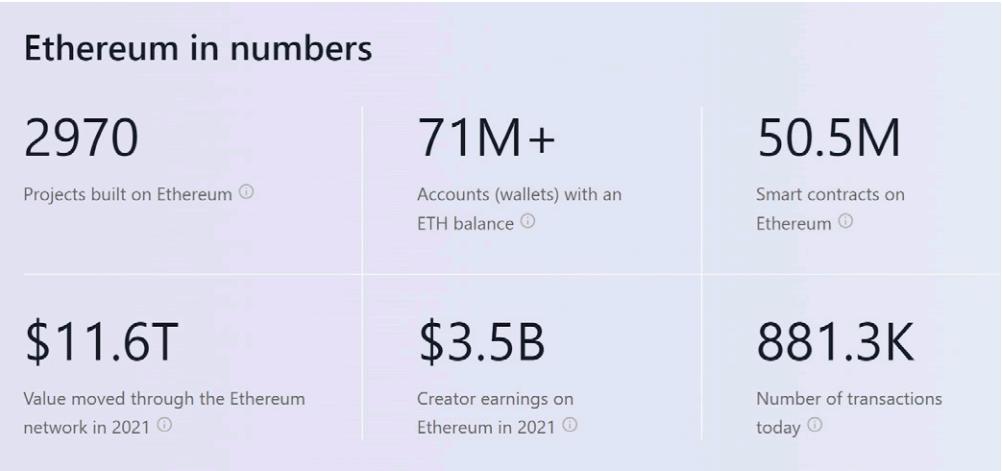
image description
Figure: Ethereum Indicators
Fundamental
A framework for evaluating smart contract platforms is similar to a commodity — it is a platform of consumable resources. As the demand for a good grows, the price people are willing to pay usually increases as well. Similarly, given that many SCPs require users to burn native Tokens (which we often call gas fees) to conduct transactions, the price of native SCP Tokens like ETH is usually related to the utility of the network: as the number of transactions on the network increases, the burned Token The quantity will also increase, resulting in less supply available on the market and potentially higher token value. As more useful Decentralized applications (DApps) are deployed on SCP, the demand for native tokens for payment transactions may increase.
first level title
Supply/Economic Model
Similar to Bitcoin, Ethereum’s supply mechanism is also pre-programmed. However, unlike Bitcoin, Ethereum’s supply mechanism has undergone multiple changes. Let's review these two major milestones.
1. August 2021--implement the destruction of basic fees. When Ethereum was first created, the ETH supply was distributed to miners in the form of 2 ETH per block, and 100% of transaction fees went to miners.

When the London upgrade launched, a fee burn mechanism was implemented, which included Ethereum Improvement Proposal 1 (EIP) 1559, resulting in the underlying transaction fees being burned instead of allocated to miners. Ethereum’s inflation rate is reduced as more transaction fees are burned.
Figure: Total ETH Burned Since EIP-1559
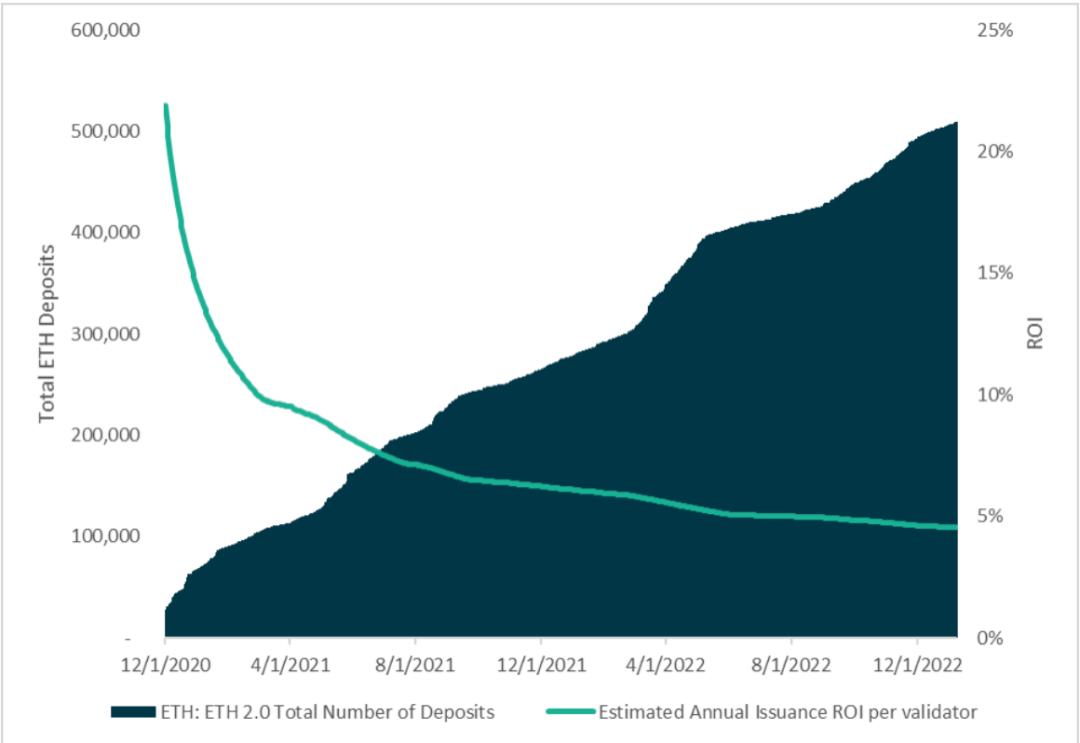
2. September 2022 - Merge + cancellation of miner rewards. After the merge, miners no longer receive block rewards. Instead, validators receive staking rewards as rewards for putting up their ether to validate transactions. Unlike mining, if they successfully mine a block, they will get a fixed reward of 2 ETH per block, while staking provides a variable staking rate for all pegged stakers, which depends on the entire ecosystem The total amount of ETH pledged. A higher ETH staking volume results in a lower Annual Rate Rate (APR) per staker, and vice versa. As of December 2022, an ETH investor earns an annualized rate of 4% with a total investment of 15.9 million ETH.
image description
Figure: Annualized ETH Pledge and Total ETH Pledged Deposit
Simple Supply Dynamics Model Walkthrough
Taking these two events into account, investors can form a model of supply dynamics.
1. Framework: First, create two columns: before merge and after merge. This is to compare pre-consolidation versus post-consolidation inflation.
2. Supply: Create a supply portion and break down inflation through staking rewards and mining rewards.
Mining rewards: Mining rewards only exist before the merger, and each block provides 2 ETH. Given an average of ~6,250 blocks per day, and a year with 365 days, 2 ETH/block * 6250 blocks/day * 365 days/year = ~4.6 million ETH/year. Mining rewards disappear after merging.
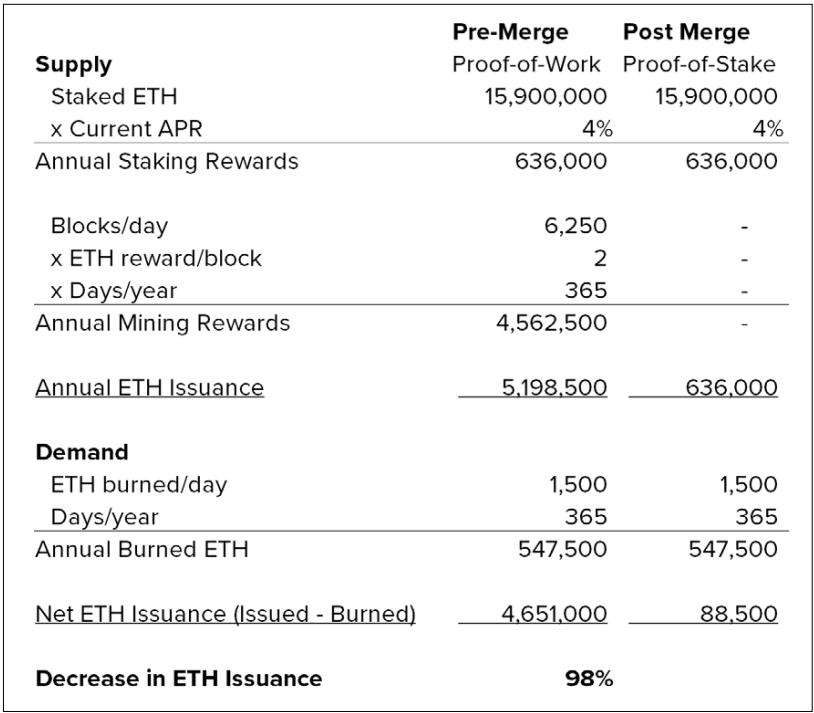
3. Demand: This can be calculated by estimating the average amount of ETH burned per day. We can use 1500 ETH/day as a basis to assume 4/1500 ETH/day * 365 days/year = about 550,000 ETH burned per year.
Figure: Issuance Model of ETH
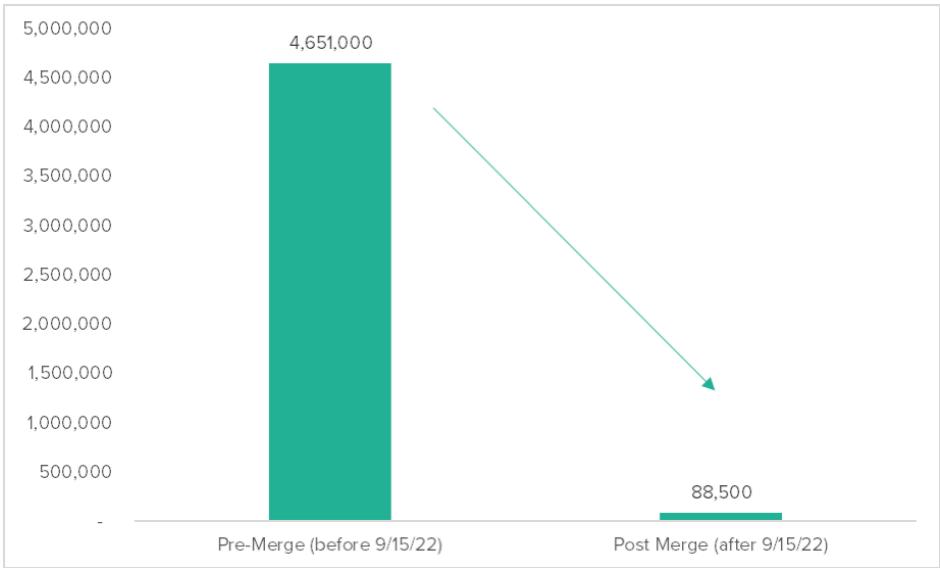
By comparing previous proof-of-work issuance to proof-of-stake issuance, we can apply the assumptions of the model and see an annualized decline of over 98% in total issuance.
image description
Figure 5: ETH Annual Circulation Changes
"A change in ETH issuance is equivalent to more than three BTC halvings. Assuming that the Ethereum ecosystem develops in the future, the destruction of ETH brought about by the increase in the number of transaction fees may exceed the issuance, which may cause ETH to become a deflationary asset. Keeping track of upcoming changes to the Ethereum protocol and understanding the impact of those changes on the total supply is critical for any potential investor."
"Unlike most payment cryptoassets such as Bitcoin, which have not undergone significant changes in supply dynamics, SCP appears to have made more significant changes to its codebase due to working on a more complex infrastructure. As a result, certain structural dynamics such as supply are subject to occasional sharp shifts. As an investor, it is important to understand the second order effects of large changes in supply dynamics. For example, after Token inflation has dropped significantly (such as EIP-1559 and after the merger), imagine a scenario where people believe that the intrinsic value of Ethereum is relatively stable. Given that the sell pressure of ~4.5M ETH per year from miners is reduced to zero (since miners no longer receive block rewards), and assuming that market prices remain relatively stable in the short term, one can ask such questions."
What happens to the price if demand stays the same without 4.5 million ETH selling pressure for a year?
What happens to price if demand stays the same but ETH becomes deflationary?
If investors believe that the market has not yet priced in the full impact of a lower token inflation rate, which they view as bullish, they can buy the asset.
While the first two changes (EIP-1559 and the merger) represent the most obvious shifts in supply and demand dynamics, they are not comprehensive. Other changes that could affect these dynamics include.
1. Changes in monetary policy: If the Ethereum network changes the way it creates new ETH, this will most likely affect the supply of ETH and thus its price. As more people and organizations look to use Ethereum, this could increase demand for the ETH network.
2. Changes in use cases: If the Ethereum code base is modified to expand the range of applications that can be built on the platform, this may increase the demand for ETH as more people and organizations want to use the Ethereum network.
Token distribution

image description
Figure: Advanced Token Economics of Various SCPs
first level title
need
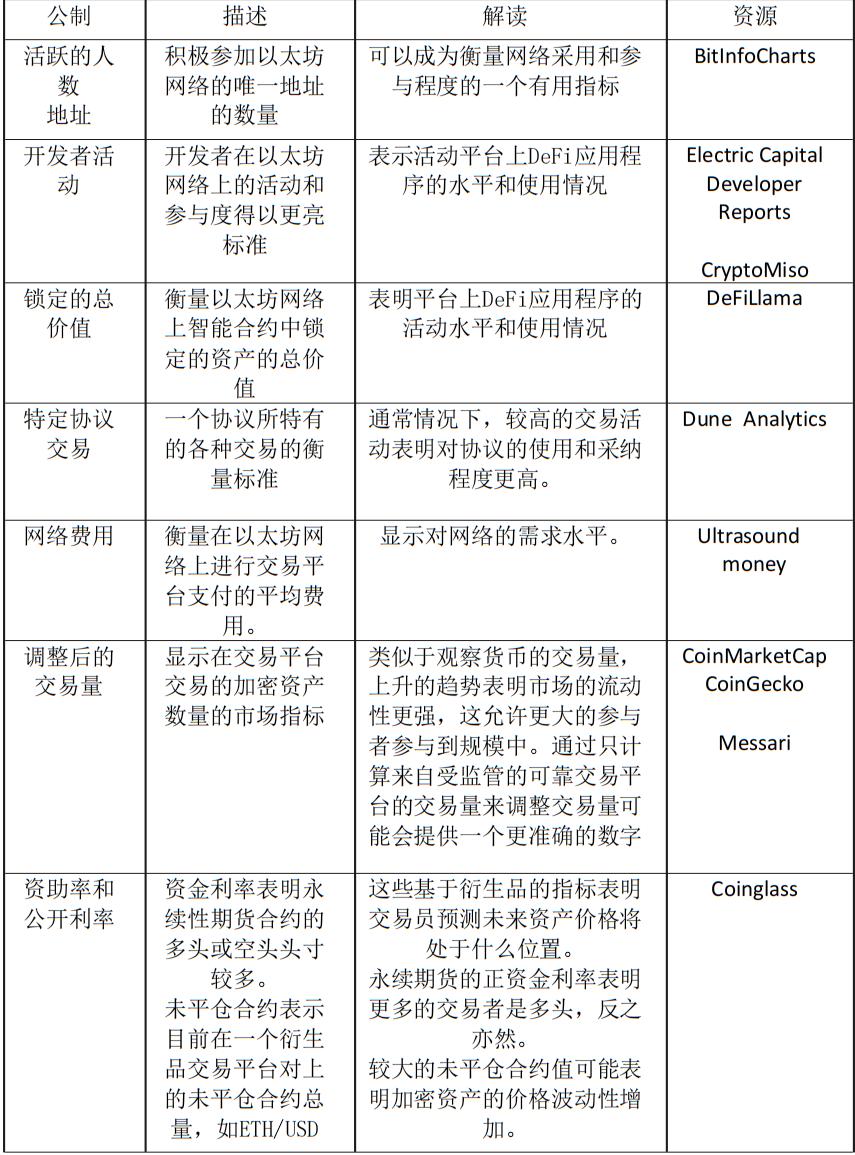
Quantitative indicators
We used burning 1500 ETH per day as a proxy for demand in the issuance model above, but what are some fundamental factors for this demand? Below we examine some quantitative metrics that can be used to determine demand.
Some quantitative metrics to monitor include:
1. Development roadmap: The development roadmap of the blockchain network can provide insight into the long-term vision and direction of the project. People need to understand the development priorities and goals of the Ethereum network, and how they affect the network over time.
3. Regulatory environment: The regulatory environment in which a blockchain network operates can have a significant impact on its development and adoption. It is important to understand the regulatory environment surrounding Ethereum and the impact it may have on the network in the future.
4. Institutional Adoption: Announcements that large or existing financial institutions plan to offer certain services may be positive for prices in the long run, as these platforms have a large number of users who may be net buyers of increments.
case analysis
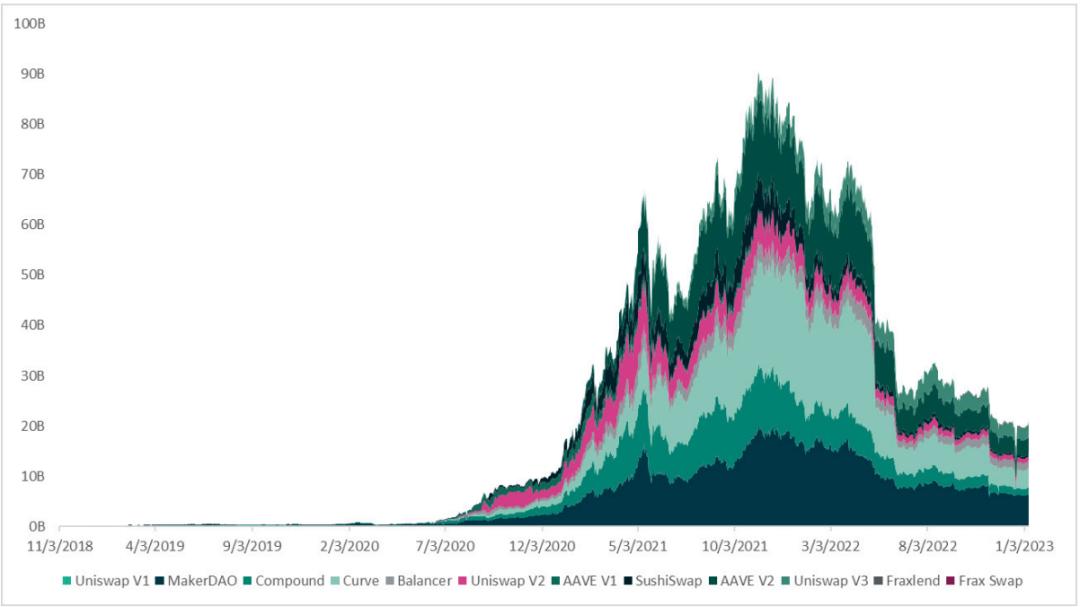
Since the value of Ethereum is tied to the use of DApps, it is useful to understand which use cases have found a niche in the user ecosystem. Understanding the range of successful applications on Ethereum can help us identify areas where demand is likely to grow in the event of wider usage in the future.
image description
Figure: Total Locked Value of Leading Ethereum DeFi DApps
Imagine that Alice and Bob want to trade some digital assets, but they don't want to use a traditional trading platform, preferring to avoid the risks that may arise with a Centralized entity. Instead, they decided to use a non-centralized exchange (DEX), which is a platform that allows them to trade assets with each other, without the need for a centralized exchange. DEXs have some advantages over traditional trading platforms.

Given that this is a technology that allows permissionless asset transactions, as shown in Figure 8 below, the popularity has increased significantly.
Figure: Uniswap’s Cumulative USD Trading Volume
loan agreement
Although DEX is still in its infancy and still lacks functionality and user experience compared to Centralized trading platforms, Uniswap’s total DEX volume on Ethereum reached over $350 billion in May 2022, indicating market fit . As DEXs continue to develop and gradually improve, they will take more market share from Centralized trading platforms.
Imagine a scenario where Alice wants to borrow XYZ from Bob without selling her ETH. Alice sends some ETH to the protocol as collateral, a security deposit that Bob can use to cover any losses if Alice doesn't repay the loan. Bob agrees to lend Alice XYZ, and the lending protocol uses a smart contract to handle the loan terms and repayment schedule. The smart contract automatically tracks the loan, including how much Alice owes, the interest rate, and the repayment schedule. When Alice repays the loan, the smart contract automatically returns the collateral to her. Once the loan is fully repaid, the smart contract marks the loan as complete and the process is over.
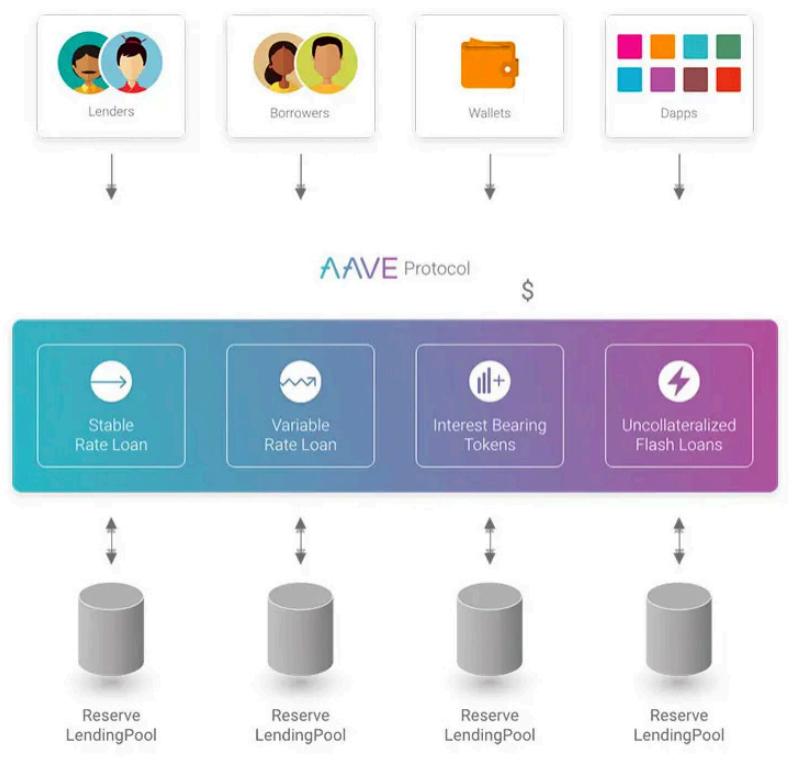
In the diagram below, protocols like Aave use smart contracts to provide users with a variety of financial instruments, including stable-rate loans, variable-rate loans, and interest-bearing loans. Through smart contracts, lending protocols like Aave provide users with an automated way to obtain various financial services that only traditional banks have provided in the past, as well as obtain flash loans that do not yet exist in traditional finance.
Figure: Aave Lending Protocol
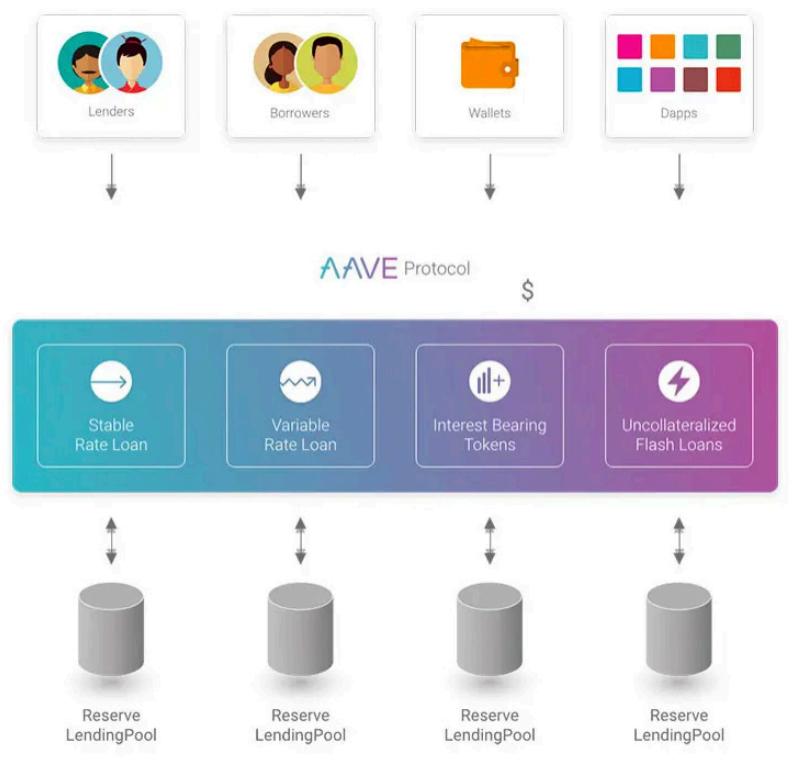
Like DEXs, lending protocols are growing in popularity, with billions of dollars worth of tokens deposited using Aave as a proxy over the past two years:
image description
Figure: Aave's total lock-up volume
Lending protocols also offer advantages such as decentralization, privacy, and accessibility. Additionally, other advantages of lending protocols over traditional lenders include:
Speed: Loans are instantly collateralized, so users can borrow immediately without delay, unlike dealing with traditional lenders.
Automated Execution: Repayment schedules, interest payments, and liquidations are all handled automatically by the protocol smart contract.
Yield: Lending crypto assets for interest allows users to earn yield on borrowing demand.
Transparency: Loan settlement price, mortgage amount, borrowing rate and interest rate are completely transparent to users, and anyone can verify the balance on the chain.
DApp Research
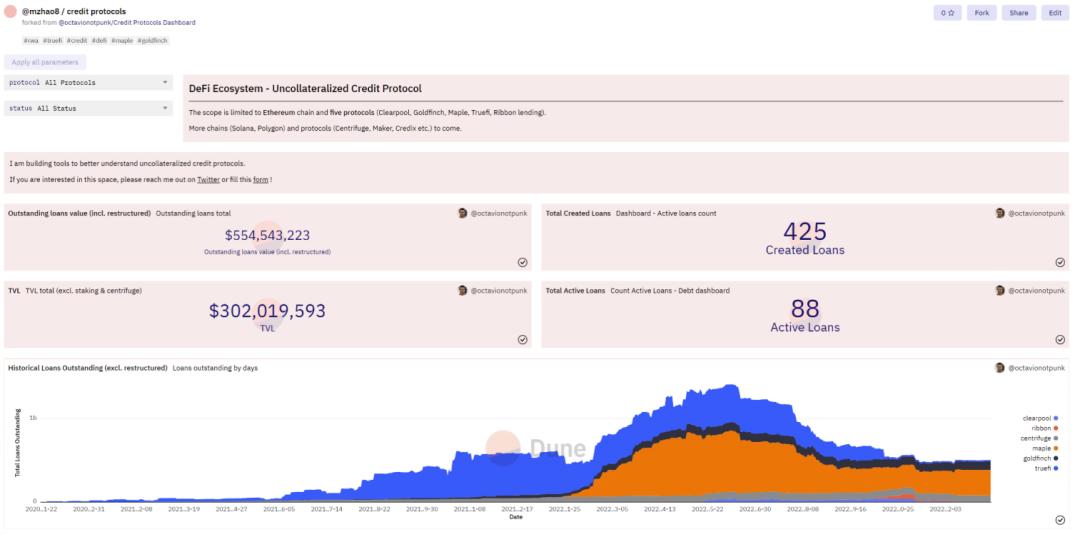
Various DApps serve different purposes; there is no one-size-fits-all approach to gauging demand when researching a project. However, using a free data resource like Dune Analytics can help investors focus on specific metrics unique to the DApp industry. For example, if someone wanted to look at the total size of the unsecured credit protocol market on Ethereum, they could search for "unsecured credit protocol" on Dune.com and find various dashboards to track various unsecured credit protocol metrics such as Total loans created, active loans, etc.
image description
Figure: Screenshot of Dune Dashboard
If investors want to figure out whether underlying demand for SCP is sticky, using a tool like Dune allows users to draw various types of graphs to measure usage of various protocols. Assuming overall, the data shows high stickiness and usage of consumer DApps, it could be a factor in favor of long-term investment in SCPs.
form of competition
While Ethereum accounts for the majority of the market cap and total value locked, there are other smart contract platforms that compete directly with Ethereum:
As a blockchain focused on Decentralized finance and games, Avalanche claims to be able to process thousands of transactions per second and is fully compatible with Ethereum. Developers can easily port applications from Ethereum to Avalanche. The Avalanche blockchain architecture includes subnets, which are independent networks that can run different types of DApps. Each subnet is independent, has its own set of validators, consensus rules, and governance structure, and can leverage the security and decentralized features of the main network.

image description
Figure: Activity of leading smart contract blockchains
first level title
Investor Checklist
General information
1. Market demand and adoption: A platform with strong market demand and adoption may be more attractive to investors, as it indicates that there is a strong user base and developer community using the platform.
2. Performance and scalability: The performance and scalability of the platform may need to be considered, as this will affect the user experience and the ability of the platform to handle a large number of transactions and users.
3. Security: Any smart contract platform should consider security, as a bug or hack can have significant consequences for users and investors.
5. Team and Governance: The team and governance structure of the platform are also factors to consider, as the platform's leadership and decision-making process will affect its direction and success.
economic model
6. Ecosystem and partnerships: The strength of the platform's ecosystem and partnerships with other companies and organizations are also key factors for its success.
economic model
1. Token issuance and distribution: How are Tokens issued and distributed? Is it pre-mined, or mined via a proof-of-work or proof-of-stake mechanism? How are tokens distributed to early supporters and developers, and how are they provided to the wider market?
first level title
Summarize
The supply and demand dynamics of smart contract platforms are driven by a range of factors, including market demand and adoption, performance and scalability, security, regulatory environment, teams and governance, and ecosystems and partnerships.
Summarize
The supply and demand dynamics of smart contract platforms are driven by a range of factors, including market demand and adoption, performance and scalability, security, regulatory environment, teams and governance, and ecosystems and partnerships.



